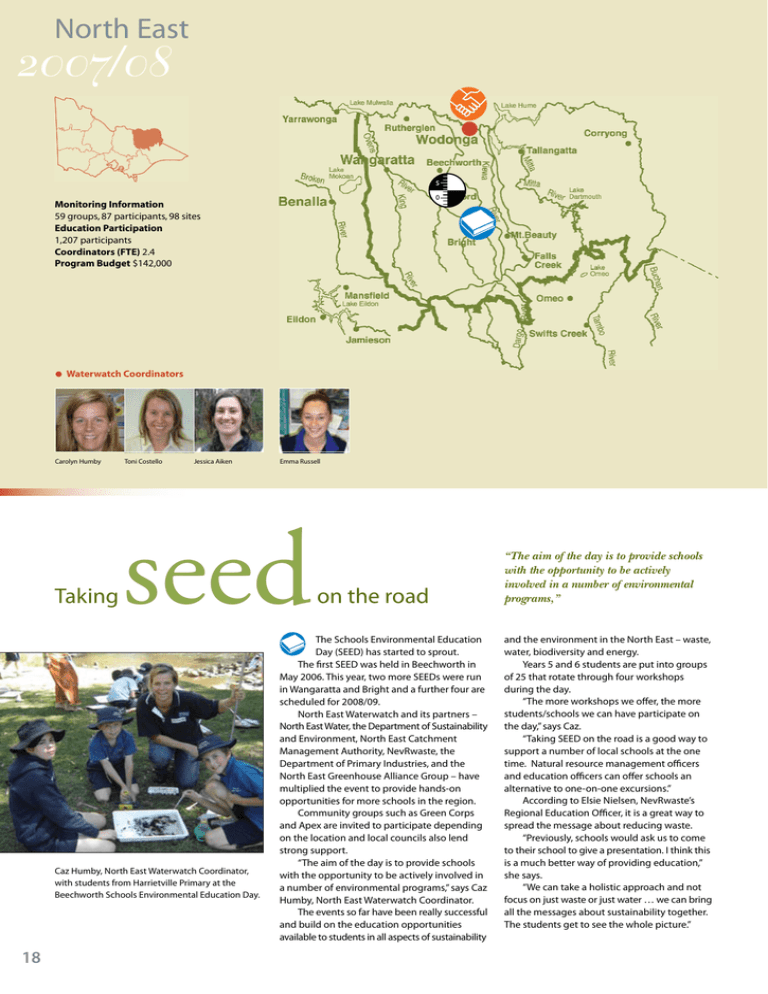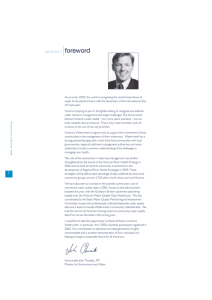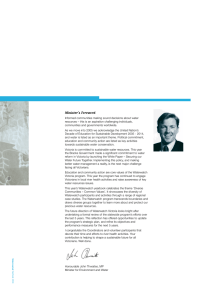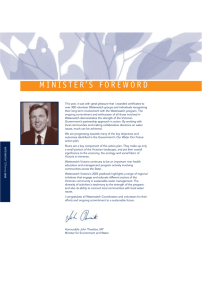seed 2007/08 North East •
advertisement

North East 2007/08 Monitoring Information 59 groups, 87 participants, 98 sites Education Participation 1,207 participants Coordinators (FTE) 2.4 Program Budget $142,000 • Waterwatch Coordinators Carolyn Humby Taking Toni Costello Jessica Aiken Emma Russell seed Caz Humby, North East Waterwatch Coordinator, with students from Harrietville Primary at the Beechworth Schools Environmental Education Day. 18 on the road The Schools Environmental Education Day (SEED) has started to sprout. The first SEED was held in Beechworth in May 2006. This year, two more SEEDs were run in Wangaratta and Bright and a further four are scheduled for 2008/09. North East Waterwatch and its partners – North East Water, the Department of Sustainability and Environment, North East Catchment Management Authority, NevRwaste, the Department of Primary Industries, and the North East Greenhouse Alliance Group – have multiplied the event to provide hands-on opportunities for more schools in the region. Community groups such as Green Corps and Apex are invited to participate depending on the location and local councils also lend strong support. “The aim of the day is to provide schools with the opportunity to be actively involved in a number of environmental programs,” says Caz Humby, North East Waterwatch Coordinator. The events so far have been really successful and build on the education opportunities available to students in all aspects of sustainability “The aim of the day is to provide schools with the opportunity to be actively involved in a number of environmental programs,” and the environment in the North East – waste, water, biodiversity and energy. Years 5 and 6 students are put into groups of 25 that rotate through four workshops during the day. “The more workshops we offer, the more students/schools we can have participate on the day,” says Caz. “Taking SEED on the road is a good way to support a number of local schools at the one time. Natural resource management officers and education officers can offer schools an alternative to one-on-one excursions.” According to Elsie Nielsen, NevRwaste’s Regional Education Officer, it is a great way to spread the message about reducing waste. “Previously, schools would ask us to come to their school to give a presentation. I think this is a much better way of providing education,” she says. “We can take a holistic approach and not focus on just waste or just water … we can bring all the messages about sustainability together. The students get to see the whole picture.” Partners grow the SEED North East Waterwatch and its partners have put together a regionally focussed online education package to support their successful Schools Environment Education Day. The Schools Environment Education Directory (another SEED) has been developed as an online resource for schools in the North East. The first stage of the website will be launched in July 2008. A SEED project officer has worked closely with each of the partners – North East Waterwatch, Indigo Shire Council, NevRwaste, the North East Greenhouse Alliance Group, the Rural City of Wangaratta and North East Water – to develop comprehensive units of work. The education package is aligned with the school curriculum and the Victorian Essential Learning Standards, with content designed to engage and involve students and teachers. The units provide learning resources for teachers to deliver lessons based on a number of environmental themes relevant to the region that address recent environmental changes in the North East, including the impact of the drought and climate change. The North East Catchment Management Authority will host the SEED website. There will be four main themes: water, waste, biodiversity and energy. “We envisage that teachers will download the work units at the start of the school year and plan their lessons around this information,” says Caz Humby, Regional Waterwatch Coordinator. All of the units will include incursions and excursions available in the area, hands-on and interactive activities for students and additional resources and links to assist teachers in delivering the lessons. The SEED steering committee worked with an educational consultant to get the package right for the target group and incorporated learning strategies such as brainstorming and round robins where every student in the class can get involved. “We hope it provides a fun, interactive and a great learning tool for teachers,” says Caz “Importantly, we hope it motivates and assists them in delivering environmental sessions.” Understanding to Mudgegonga Waterwatcher, Bernard Carroll. “The community feeling was that the area didn’t have a salinity problem, but monitoring results have proved otherwise.” The home page of the Schools Environment Education Directory (SEED) at www.necma.vic.gov. au/ResourceLibrary/ForSchools. “We hope it provides a fun, interactive and a great learning tool for teachers.” action To look at the Mudgegonga area, near Myrtleford in the North East, it seems a picturesque farming landscape, but there are some quiet lurking problems that require action. Fortunately, the local Landcare Group is on to it. In February 2007 the group started water quality monitoring on three waterways that flow into the Ovens River because Mudgegonga had been pinpointed as a source of poor water quality. The Ovens is listed as one of Victoria’s Heritage Rivers requiring special protection and careful management, so it was an important task. The Landcare Group monitors eight sites and hopes that by early 2009, with two year’s of data under their belt, they will be in a good position to understand the situation and the problems, and can work out what to do about it. According to Paula Pipan, one of the five regular monitors, the community feeling was that the area didn’t have a salinity problem, but monitoring results have proved otherwise. The North East Waterwatch team analyses the group’s monthly data and develops an annual report that demonstrates how the results compare against the objectives of the State Environment Protection Policies (SEPP). “We know of some problem spots that need remedial works,” says Paula, but it’s the whole picture they want to know. “Then we have to get all landholders who have waterway frontage involved, not just Landcare members.” To bring about change, she believes it’s a matter of getting people to understand the possibilities of what can be achieved. “We need to get across that they can make a difference. We need to show them what’s in it for them and how the change can be positive for them.” Partners and Sponsors of the North East Waterwatch Program Natural Heritage Trust, North East Catchment Management Authority, Department of Primary Industries, Environmental Protection Authority, Indigo Shire, Murray Darling Freshwater Research Centre, North East Victorian Regional Waste Management Group, North East Greenhouse Alliance, North East Water, Rural City of Wangaratta, Rural City of Wodonga, Wonga Wetlands. 19


